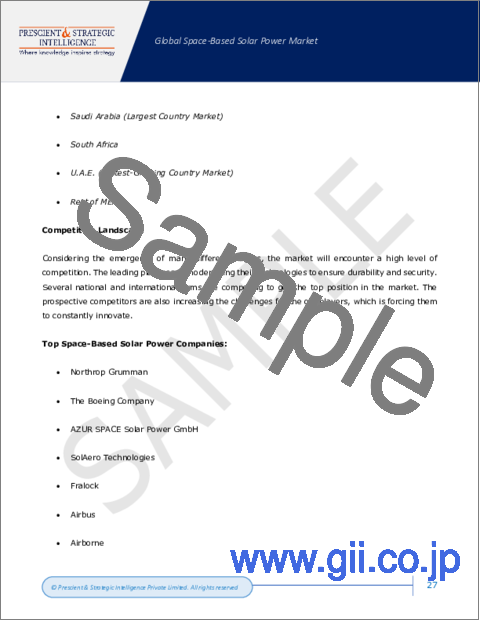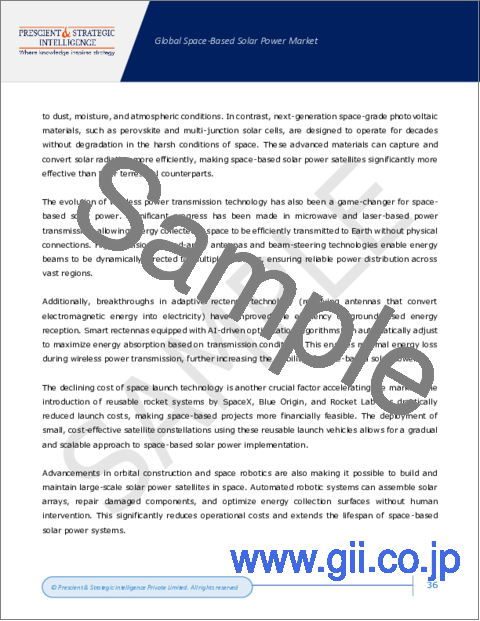|
|
市場調査レポート
商品コード
1497695
宇宙太陽光発電の世界市場(2030年~2035年)-市場規模・シェア分析、業界動向、成長予測Space-Based Solar Power Market Report (2030 - 2035) - Size and Share Analysis, Industry Trends, and Growth Forecasts |
||||||
|
|||||||
| 宇宙太陽光発電の世界市場(2030年~2035年)-市場規模・シェア分析、業界動向、成長予測 |
|
出版日: 2024年04月23日
発行: Prescient & Strategic Intelligence
ページ情報: 英文 220 Pages
納期: 2~3営業日
|
全表示
- 概要
- 目次
宇宙太陽光発電の市場規模は、2030年に41億5,120万米ドルに達し、今後はさらに4.5%のCAGRで拡大し、2035年には51億6,640万米ドルに達すると予測されています。
この産業は、再生可能でクリーンなエネルギーに対する世界のニーズの高まりに大きく影響されています。政府機関や企業は、従来のエネルギー源に代わるものを探し続けています。
電子機器の利用率の上昇、工業化、人口の急増が、こうしたエネルギー資源を重視するようになった主な要因です。宇宙を利用した太陽光発電は、昼夜のサイクルや天候に左右されることなく、再生可能エネルギーを安定供給することができます。この技術は、気候変動や温室効果ガス排出の影響を軽減しながら、エネルギー需要の増加に対応できる大きな可能性を秘めています。
宇宙を利用した太陽光発電は、過去には、高価な衛星打ち上げ、複雑な設備の必要性、エネルギー移動の少なさなど、いくつかの課題に直面していました。しかし、技術的進歩や太陽光発電材料の改良、複数の衛星打ち上げという考え方が、業界の成長機会を形成しています。こうした技術の向上は、資本の増加、各国の宇宙機関の協力、研究努力の高まりによるものです。これらの改善は、SBSPの実行可能性とコストを改善しようとするもので、この発展途上の技術のさらなる拡大と商業化を促進しています。
当レポートでは、世界の宇宙太陽光発電市場について調査し、市場の概要とともに、衛星タイプ別、用途別、エンドユーザー別、地域別の動向、および市場に参入する企業のプロファイルなどを提供しています。
目次
第1章 調査範囲
第2章 調査手法
第3章 エグゼクティブサマリー
第4章 業界専門家/KOLの声
第5章 市場指標
第6章 業界の見通し
- 市場力学
- COVID-19の影響
- ポーターのファイブフォース分析
- バリューチェーン分析
- 技術分析
- 規制の枠組み
第7章 競合情勢
第8章 世界市場
- 概要
- 衛星タイプ別市場収益(2017年~2030年)
- 用途別市場収益(2017年~2030年)
- エンドユーザー別市場収益(2017年~2030年)
- 地域別市場収益(2017年~2030年)
第9章 北米市場
第10章 欧州市場
第11章 アジア太平洋市場
第12章 ラテンアメリカ市場
第13章 中東・アフリカ市場
第14章 企業プロファイル
- Northrop Grumman
- AZUR SPACE Solar Power GmbH
- Fralock
- EMROD Inc.
- The Boeing Company
- SolAero Technologies
- Airbus
- SpaceTech
- Virtus Solis Technologies
第15章 付録
Key Insights
The space-based solar power market will reach USD 4,151.2 million in 2030, and it will further grow at a 4.5% CAGR to reach USD 5,166.4 million, by 2035.
The industry is largely influenced by the growing need for renewable and clean energy worldwide. Government organizations and companies are continuously searching for alternatives to conventional energy sources.
The rising utilization of electronic devices, industrialization, and surging population are the major factors that are resulting in the rising emphasis on these energy resources.
Space-based solar power can provide a constant supply of renewable energy without interference by the day-night cycle and weather.
This technology has great potential to cater to the rising need for energy while decreasing the effects of climate change and greenhouse gas emissions.
Space-based solar power, in the past, faced several challenges, including expensive satellite launches, the requirement for intricate facilities, and less energy transfer.
However, Technological advancements and improvements in PV materials, along with the idea of multiple satellite launches, have formed a growth opportunity for the industry.
These improvements in technologies are because of the increasing capital, collaboration among space agencies of different nations, and rising research efforts.
These improvements seek to improve the viability and cost of SBSP, which is promoting the further expansion and commercialization of this developing technology.
New ideas like portable solar cells, which are grounded on, laser technology, automation, and microwave technology are now being researched by academic institutions and businesses.
Key Insights
North America will be the largest contributor to the industry. This continent has an advanced space exploration environment, which comprises satellite manufacturing sites, space station associations, and launch facilities.
Regional governments and reputable aerospace firms are also funding in space-based solar power technology development.
The microwave-transmitting solar satellites category will be the largest contributor to the industry in 2030, with an 80% share.
These satellites are a well-known as well as proven vehicles that have been subjected to substantial studies. This has built trust in them among investors and organizations.
The electricity generation category will account for the leading share in 2030. This can be ascribed to the surging need for power in different sectors and the rising emphasis on generating power sustainably.
The power produced by the SBSP setup can be transmitted to different remote areas smoothly, without any wired connection. It can offer renewable and consistent energy for businesses, industries, and homes.
The government and defense category is expected to lead the industry in 2030. This will be because governments are largely investing and taking the required initiatives to guarantee a constant electricity supply and enhance energy security.
Defense agencies demand durability and reliability, and they rely on a continuous energy supply for important tasks in remote or harsh environments.
The space-based solar power industry is expected to be highly competitive because of the appearance of many different players. The top players are reforming their technologies to guarantee security and durability.
Some international and national companies are contending to attain the top spot in the industry. The potential competitors are also boosting the challenges for the old companies, which is driving them to innovate regularly.
Table of Contents
Chapter 1. Research Scope
- 1.1. Research Objectives
- 1.2. Market Definition
- 1.3. Analysis Period
- 1.4. Market Size Breakdown by Segments
- 1.4.1. Market size breakdown, by satellite type
- 1.4.2. Market size breakdown, by application
- 1.4.3. Market size breakdown, by end user
- 1.4.4. Market size breakdown, by region
- 1.5. Market Data Reporting Unit
- 1.5.1. Value
- 1.6. Key Stakeholders
Chapter 2. Research Methodology
- 2.1. Secondary Research
- 2.1.1. Paid
- 2.1.2. Unpaid
- 2.1.3. P&S Intelligence database
- 2.2. Primary Research
- 2.3. Market Size Estimation
- 2.4. Data Triangulation
- 2.5. Currency Conversion Rates
- 2.6. Assumptions for the Study
- 2.7. Notes and Caveats
Chapter 3. Executive Summary
Chapter 4. Voice of Industry Experts/KOLs
Chapter 5. Market Indicators
Chapter 6. Industry Outlook
- 6.1. Market Dynamics
- 6.1.1. Trends
- 6.1.2. Drivers
- 6.1.3. Restraints/challenges
- 6.1.4. Impact analysis of drivers/restraints
- 6.2. Impact of COVID-19
- 6.3. Porter's Five Forces Analysis
- 6.3.1. Bargaining power of buyers
- 6.3.2. Bargaining power of suppliers
- 6.3.3. Threat of new entrants
- 6.3.4. Intensity of rivalry
- 6.3.5. Threat of substitutes
- 6.4. Value Chain Analysis
- 6.5. Technology Analysis
- 6.6. Regulatory Framework
Chapter 7. Competitive Landscape
- 7.1. List of Market Players and their Offerings
- 7.2. Competitive Benchmarking of Key Players
- 7.3. Product Benchmarking of Key Players
- 7.4. Recent Strategic Developments
- 7.5. Investment by Players
Chapter 8. Global Market
- 8.1. Overview
- 8.2. Market Revenue, by Satellite Type (2017-2030)
- 8.3. Market Revenue, by Application (2017-2030)
- 8.4. Market Revenue, by End User (2017-2030)
- 8.5. Market Revenue, by Region (2017-2030)
Chapter 9. North America Market
- 9.1. Overview
- 9.2. Market Revenue, by Satellite Type (2017-2030)
- 9.3. Market Revenue, by Application (2017-2030)
- 9.4. Market Revenue, by End User (2017-2030)
- 9.5. Market Revenue, by Country (2017-2030)
Chapter 10. Europe Market
- 10.1. Overview
- 10.2. Market Revenue, by Satellite Type (2017-2030)
- 10.3. Market Revenue, by Application (2017-2030)
- 10.4. Market Revenue, by End User (2017-2030)
- 10.5. Market Revenue, by Country (2017-2030)
Chapter 11. APAC Market
- 11.1. Overview
- 11.2. Market Revenue, by Satellite Type (2017-2030)
- 11.3. Market Revenue, by Application (2017-2030)
- 11.4. Market Revenue, by End User (2017-2030)
- 11.5. Market Revenue, by Country (2017-2030)
Chapter 12. LATAM Market
- 12.1. Overview
- 12.2. Market Revenue, by Satellite Type (2017-2030)
- 12.3. Market Revenue, by Application (2017-2030)
- 12.4. Market Revenue, by End User (2017-2030)
- 12.5. Market Revenue, by Country (2017-2030)
Chapter 13. MEA Market
- 13.1. Overview
- 13.2. Market Revenue, by Satellite Type (2017-2030)
- 13.3. Market Revenue, by Application (2017-2030)
- 13.4. Market Revenue, by End User (2017-2030)
- 13.5. Market Revenue, by Country (2017-2030)
Chapter 14. Company Profiles
- 14.1. Northrop Grumman
- 14.1.1. Business overview
- 14.1.2. Product and service offerings
- 14.1.3. Key financial summary
- 14.2. AZUR SPACE Solar Power GmbH
- 14.2.1. Business overview
- 14.2.2. Product and service offerings
- 14.2.3. Key financial summary
- 14.3. Fralock
- 14.3.1. Business overview
- 14.3.2. Product and service offerings
- 14.3.3. Key financial summary
- 14.4. EMROD Inc.
- 14.4.1. Business overview
- 14.4.2. Product and service offerings
- 14.4.3. Key financial summary
- 14.5. The Boeing Company
- 14.5.1. Business overview
- 14.5.2. Product and service offerings
- 14.5.3. Key financial summary
- 14.6. SolAero Technologies
- 14.6.1. Business overview
- 14.6.2. Product and service offerings
- 14.6.3. Key financial summary
- 14.7. Airbus
- 14.7.1. Business overview
- 14.7.2. Product and service offerings
- 14.7.3. Key financial summary
- 14.8. SpaceTech
- 14.8.1. Business overview
- 14.8.2. Product and service offerings
- 14.8.3. Key financial summary
- 14.9. Virtus Solis Technologies
- 14.9.1. Business overview
- 14.9.2. Product and service offerings
- 14.9.3. Key financial summary
Chapter 15. Appendix
- 15.1. Abbreviations
- 15.2. Sources and References
- 15.3. Related Reports





